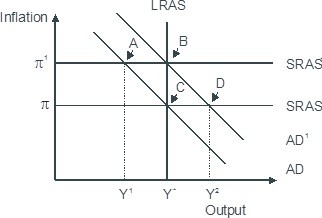Both Kate and Kyle own saltwater taffy factories. Kate's factory has low fixed costs and high variable costs. Kyle's factory has high fixed costs and low variable costs. Currently, each factory is producing 1,000 boxes of taffy at the same total cost. Complete the following statement with the correct answer. If each produces
A) less, their costs will be equal.
B) more, their costs will be equal.
C) more, the costs of Kate's factory will exceed those of Kyle's factory.
D) less, the costs of Kate's factory will exceed those of Kyle's factory.
C) more, the costs of Kate's factory will exceed those of Kyle's factory.
You might also like to view...
Based on the figure below. Starting from long-run equilibrium at point C, an increase in government spending that increases aggregate demand from AD to AD1 will lead to a short-run equilibrium at point ________ creating _____gap. 
A. D; an expansionary B. B; no output C. B; expansionary D. A; a recessionary
Refer to Table 4-3. The table above lists the marginal cost of cowboy hats by The Waco Kid, a firm that specializes in producing western wear. If the market price of cowboy hats is $50, producer surplus is
A) $0. B) $4. C) $62. D) $138.
According to the theory of purchasing power parity, why should identical goods have the same price in different locations?
a. To prevent price gouging, international law mandates that identical goods must be sold for the same currency-adjusted price across all locations. b. If the goods were two different prices, it would cause an increase in supply of the good at the low-price location and a decrease in supply of the good at the high-price location, which would cause the prices in each location to converge to the same price. c. If the goods were two different prices, it would cause an increase in supply of the good at the high-price location and a decrease in supply of the good at the low-price location, which would cause the prices in each location to converge to the same price. d. If the goods were two different prices, it would cause a decrease in demand of the good at the low-price location and an increase in demand of the good at the high-price location, which would cause the prices in each location to converge to the same price.| e. If the good were two different prices, it would cause an increase in demand of the good solely at the low-price location until that good reached the sameprice as the good in the high-price location.
The percentage of national income spent on health care
A. has steadily decreased since 1965. B. decreased until the end of the 1970s and then increased in the 1980s and 2000s. C. increased until the end of the 1970s and then decreased in the 1980s and 2000s. D. has steadily increased since 1965.